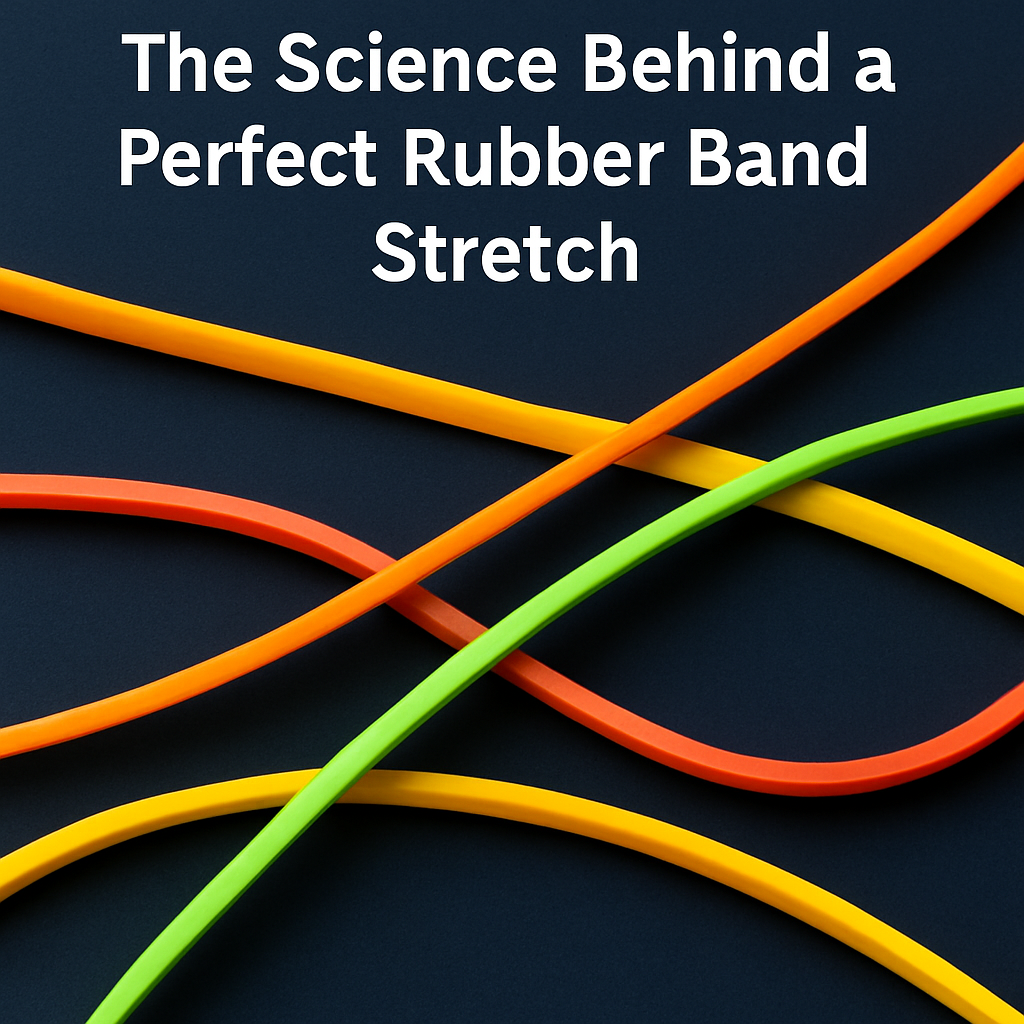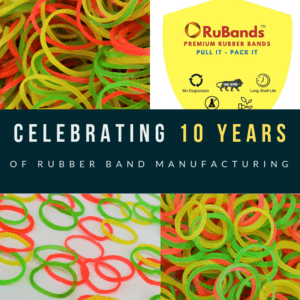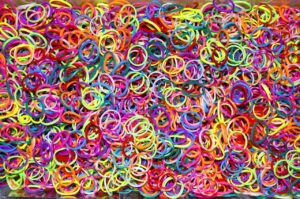The Science Behind a Perfect Rubber Band Stretch
We do it every day without a second thought. We pick up a rubber band, stretch it around a stack of papers or a bag of produce, and let it snap securely into place. This simple act is a perfect demonstration of applied physics, yet we rarely consider the incredible science at play. What gives a rubber band its signature stretch? Why does it snap back into shape, and what determines its breaking point? This isn’t just a matter of simple stretching; it’s a fascinating dance of molecules governed by the laws of thermodynamics and material science.
Welcome to the world of rubber band science. Behind every reliable, durable rubber band is a deep understanding of polymer chemistry, stress-strain relationships, and advanced manufacturing techniques. The difference between a high-quality band that performs consistently and a cheap one that snaps unexpectedly lies in the mastery of these scientific principles. At RuBands, we have built our reputation on this mastery. In this article, we will pull back the curtain on the complex rubber technology that powers the perfect stretch, exploring the core concepts of elasticity and tensile strength to reveal the hidden genius within this everyday object.
The Molecular Dance: Unraveling the Mystery of Elasticity
To understand why a rubber band stretches, we need to zoom in—way in—to the molecular level. Natural rubber is a polymer, which means it’s made of incredibly long, chain-like molecules called polyisoprene. The best way to visualize these chains in their resting state is to think of a bowl of cooked spaghetti. They are jumbled, tangled, and coiled in a completely random, disordered arrangement. This jumbled state is key to everything that follows.
In scientific terms, this disordered state has high entropy. Entropy is a fundamental concept in physics that, in simple terms, measures the amount of randomness or disorder in a system. Systems in nature, from galaxies to molecules, will always tend toward the state of greatest disorder, as it is the most statistically probable and stable arrangement. The polymer chains in a rubber band are a perfect example of this universal law.
- At Rest (High Entropy): The polymer chains are coiled and entangled, representing a state of maximum disorder. This is their natural, lowest-energy, and most stable state. They are content in their chaos.
- Under Tension (Low Entropy): When you begin to stretch the rubber band, you are applying an external force and adding energy to the system. This force pulls on the tangled polymer chains, causing them to uncoil and align themselves in a more parallel, orderly fashion in the direction of the pull. This alignment creates a more structured state, which means the entropy of the system decreases significantly. The system is now in an unnatural, high-energy state it wants to escape from.
- The Snap-Back (Return to High Entropy): The magic of elasticity happens upon release. Because the universe favors disorder, the now-aligned polymer chains have a powerful, natural tendency to return to their original jumbled, high-entropy state. This molecular rush back to randomness is what generates the powerful retracting force you feel. The stored energy is released, causing the band to snap back to its original size with remarkable speed. It’s not just “springiness”; it’s thermodynamics in action.
This thermodynamic principle is also why a quality rubber band feels “lively.” The efficiency of this transition from low to high entropy determines the quality of the snap-back. Inferior rubber might have broken chains or impurities that hinder this process, resulting in a sluggish or incomplete return to form.
Tensile Strength: Understanding the Ultimate Breaking Point
If elasticity is the ability to stretch and return, tensile strength is the measure of how much stretching a rubber band can endure before it fails. It is defined as the maximum amount of stress a material can withstand while being pulled or stretched before it breaks. A high tensile strength is the hallmark of a durable, reliable rubber band, and achieving it is a cornerstone of modern rubber technology. This is where the true engineering comes into play.
Several critical factors determine a rubber band’s tensile strength:
- Polymer Chain Length: Longer polymer chains result in more potential for entanglement and stronger intermolecular forces (known as van der Waals forces). Think of it like trying to pull apart two hairbrushes with long bristles versus short bristles; the longer ones get more tangled and offer more resistance. High-quality raw latex, which RuBands prioritizes, is sourced from mature trees and specific climates known to produce longer polyisoprene chains.
- Cross-Linking (Vulcanization): This is perhaps the most important process in all of rubber technology. In its raw form, latex is weak, sticky, and deforms permanently under pressure. The revolutionary process of vulcanization involves heating the rubber with a curing agent, most commonly sulfur. This creates strong covalent “bridges,” or cross-links, between the individual polymer chains. These cross-links act like rungs on a ladder, preventing the chains from simply slipping past one another and breaking apart when under stress. The density of these cross-links is critical:
- Under-vulcanization: Too few cross-links result in a weak, soft, and sometimes sticky rubber that doesn’t hold its shape.
- Over-vulcanization: Too many cross-links make the rubber hard, brittle, and less elastic. It will snap with very little stretch.
The secret to a perfect rubber band is achieving the “goldilocks” zone of cross-linking, a proprietary process that RuBands has perfected to ensure maximum strength without sacrificing elasticity.
- Purity and Additives: The quality of the final product is heavily dependent on the purity of the raw rubber. Fillers, impurities, or even air bubbles can create microscopic weak points in the molecular structure. When the band is stretched, the stress concentrates at these weak points, leading to the formation of a micro-tear that then propagates rapidly, causing the band to snap.
The Unseen Forces: Advanced Concepts in Rubber Science
Beyond the basics, other scientific principles affect how a rubber band behaves over time and under different conditions. Engineering a superior product means accounting for these nuanced factors.
- Hysteresis: If you’ve ever stretched a rubber band repeatedly and quickly, you’ve noticed it gets warm. This phenomenon, known as hysteresis, reveals that the energy released when the band retracts is less than the energy you put in to stretch it. The difference is lost as heat. This energy loss is due to the internal friction of the polymer chains sliding past one another. While unavoidable, advanced compounding in rubber technology can minimize hysteresis, which is crucial for dynamic applications where the band is stretched and released continuously.
- Creep and Stress Relaxation: Have you ever used a rubber band to hold something for a long time, only to find it has become loose and slightly larger? This is a combination of two phenomena. Stress relaxation is when the retracting force of the band decreases while it is held at a constant length. The polymer chains subtly rearrange themselves to alleviate some of the internal stress. Creep is the tendency to deform permanently under a constant load. Both are the result of polymer chains slowly and irreversibly sliding past each other. The robust cross-linking in RuBands products is specifically designed to combat these effects, ensuring a longer-lasting, more secure hold.
Conclusion: The RuBands Scientific Advantage
The perfect stretch of a rubber band is far from simple. It is a precisely engineered outcome, born from a deep and practical understanding of rubber band science. From the thermodynamic drive for entropy that powers its elasticity, to the intricate network of molecular cross-links that defines its tensile strength, every aspect of its performance is deliberate. The quality you feel in a RuBands product is a direct result of our control over these scientific principles—our insistence on using long-chain polymers, our precision-managed vulcanization process, and our commitment to material purity.
When you choose a RuBands product, you are choosing more than just a piece of rubber. You are choosing a product that has been scientifically optimized at every stage of its creation to be stronger, more resilient, and more reliable. It’s the science you can feel, and the dependability your work demands.






